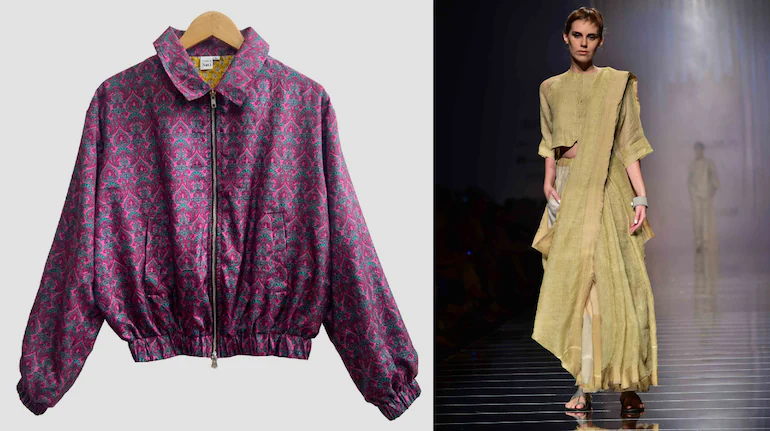I Was A Sari bomber (left); and an Anavila Misra sari that concerned experimentation with linen and khadi.
Bomber jackets constructed from Ikat materials; pantsuits from sarees; straightforward breezy tunics and breathable separates lower from handwoven cotton and linen; even a linen saree weaved with age-outdated motifs.
What was seen as a stodgy garment, printed with overused conventional motifs or simply over-embroidered, that you simply purchased for a couple of hundred rupees from a dusty handloom store, is reworked into a recent assertion of your Indianness. The silhouettes are fashionable — jackets, trousers, pants, attire, deconstructed clothes, frocks, even dhoti pants.
Also learn: 75 Indian manufacturers that modified the way in which we dwell and indulge
New-age manufacturers, style begin-ups, and established designers are introducing Indians to their heritage in methods we hardly ever considered earlier than.
There is a type of a timeline that captures how this occurred.
India’s artisanal heritage
Designer Rahul Mishra contends you can not speak about a handloom revival with out understanding the place India had on the planet textile commerce.
“The Silk Route couldn’t have been possible without having India as a large part of this trade network. Indian chintz was so sought after by the European elite in the 17th century that France had to ban it. Even Mahatma Gandhi’s politics and freedom movement put textiles at its core when he gave a call to ban videshi kapda (imported cloth) like Manchester cotton, for which our farmers were forced to grow cotton and indigo and which killed our artisanal heritage to a large degree,” Mishra says.
But we live in fashionable occasions and anybody who loves style doesn’t purchase garments primarily based on traditions alone. This is the place Indian handmade stumbled. You purchased a woven garment since you wished that one handloom factor in your wardrobe or wanted handwoven sarees for festivals and weddings.
Also learn: India@75 | Embroideries and our multicultural material
Things have modified, and the way. Jade’s Monica Shah says, “We’re approaching our artisanal legacy separate from its traditional notions, and reshaping it into globally relevant forms, thus giving these techniques a whole new flavour.”
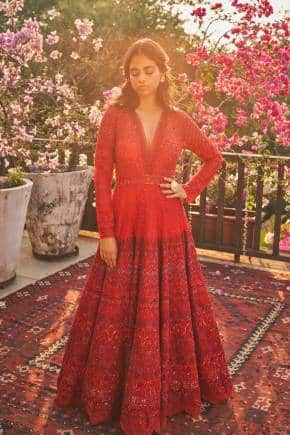 A costume by JADE.
A costume by JADE.
Luxury style and bridal couture confirmed the way in which
Indian luxurious and bridal couture have led the way in which. Designers reminiscent of Rohit Bal, Abu Sandeep, Tarun Tahiliani, and to not neglect, Sabyasachi Mukherjee, sourced a number of the most stunning materials, and revived dying embroideries and methods for one-of-a-type items and bridal couture. Textiles reminiscent of brocade, Banarasi, Kanjeevaram, and all types of silk stored a number of the heritage traditions alive.
A pioneer of the up to date Indian style business, the late Rohit Khosla was the primary to chop voluminous kurtas in crinkled cotton and used jute rope as embroidery. He had artist Gopika Nath paint on lengths of tussar silk. Abu Jani-Sandeep Khosla, impressed by costumes of Mughal courtesans, launched the ground-size Anarkali-style of churidaar-kurta, which quickly grew to become the Indian model of the ball robe. They have created masterpieces in textiles reminiscent of Khadi, Bandhani and Ajrak, and reinvented embroideries reminiscent of Chikankari and Zardozi. Bal used extravagant brocade textiles to create his signature Indo-Western look and lehengas.
It was all aspirational however past the attain of most Indians. Unfortunately, many textiles, embroideries, and methods continued to slip into anonymity.
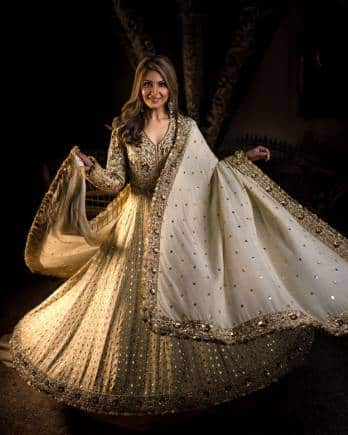 An Abu Sandeep anarkali
An Abu Sandeep anarkali
Evolution of Western silhouettes with an Indian soul
The subsequent era of style superstars reworked our notion of how we will put on Indian.
Mainstream style leaders have reinterpreted handcrafted luxurious with minimal embroidery. The trousers could also be low-slung however are lower from linen or cotton, the reversible jacket could also be one thing you put on with a kurta or shirt, however the material may very well be an ikat or the embroidery could also be aari work.
Rahul Mishra, for his debut assortment at Lakme Fashion Week, used brocade and Kerala set mundu material to hew reversible attire. He has continued to make use of intricate embroidery and textiles from clusters far aside as Kerala, Banaras, Chandheri and Maheshwari, on robes, saris, attire, and sequined bodices, in his craft-ahead model.
Anavila Misra remoulded the sari area, first along with her linen saris that have been oh-so-breathable after which with experimentations involving linen and khadi.
“To make a sari contemporary, I had to disrupt the space by adding an element of simplicity and universality,” Misra says. She collaborated with artisans from the Phulia area in West Bengal, recognized for its cotton tant saris and nice work with khadi and muslin, to create a brand new linen yarn, thought of a international yarn.
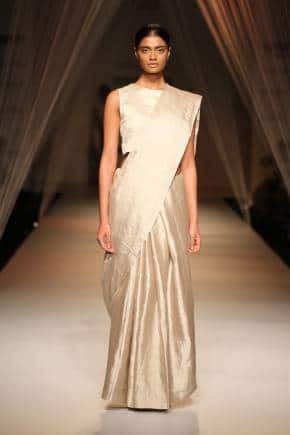 An Anavila Misra sari
An Anavila Misra sari
Amit Aggarwal makes use of conventional embroideries and methods, reminiscent of aari and zardozi, on new-age materials. “In our new collection Pedesis, we have used handlooms with polymer by first converting it into yarn,” he says.
For their label, Jade, Monica Shah and Karishma Swali have used Ek Taar (a single strand of skinny metallic) on skirts and jackets and Kasab embroidery utilizing pure silver thread on heirloom-worthy belts and jackets. “The only way to ensure the sustenance of our artisanal heritage is by taking it out of their traditional templates.”
Bodice, a winner of the Woolmark International Prize, has used a Kantha working sew as a way on their minimal Western clothes to assist construct an phantasm of a linear sample up to now. Aggarwal’s craft collaboration with Sugandha Kedia’s Dusala resulted in reversible metallic draped capes made with handwoven Pashmina.
Ujjwal Dubey’s label Antar Agni collaborates with craftsmen to create distinctive Indian materials “such as handwoven cotton, cotton with silk, and handspun-handwoven cotton, woven by weavers in Meerut, Bhagalpur, and Maheshwar,” for his menswear. “We are also constantly trying to innovate with embroideries. Even though it is not spoken about much, tailoring is another Indian skill that needs to be acknowledged.”
Antar Agni’s assortment contains tailor-made jackets of handspun materials that provide an fascinating juxtaposition of silhouette and textile.
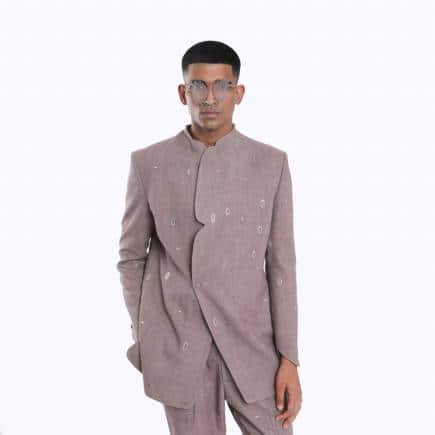 Flutter by Antar Agni
Flutter by Antar Agni
And but, it was not sufficient. It is all aspirational for many Indians and confined to the higher echelons who will pay upwards of Rs 30,000 for a easy separate like a kurta or shirt or a skirt.
The youthful labels and types redefining the Indian handcrafted business
Audacious youthful manufacturers, startups, and labels (many lower than 10 years outdated) are those actually disrupting the handloom area, creating premium collections that don’t break the bank and could be a part of your wardrobe.
Aggarwal says, “Our culture is too rich and diverse to not be preserved. It’s an uphill battle, but we’re getting there. The number of design studios that are tirelessly working to preserve their crafts is simply humbling.”
He mentions Mizoram-based Lapâr who’re preserving the work of Mizo girls weavers. “In Nagaland, Woven Threads can be preserving the misplaced craft of weaving and utilizing native motifs. In Gujarat, Jeevan Indigo is reinventing the artwork of dyeing, during which the Vankar neighborhood has taken centre stage. Some state governments have offered subsidies to such initiatives and design studios.”
I Was a Sari, which claims to be a ‘Mumbai-meets-Milan’ model, is rooted in a round financial system. They supply their uncooked supplies from vibrant Mumbai markets or use outdated saris and lifeless shares to craft stunning style merchandise reminiscent of luggage, footwear, attire, kaftans, kimonos, and shirts for as little as Rs 2,000.
 Black ikat bomber
Black ikat bomber
One of the extra thrilling manufacturers to return out of India is filmmaker and actor Kamal Hassan’s House of Khaddar. You should purchase a buttoned shirt for Rs 2,900, a cropped jacket with a buttoned mini skirt for Rs 6,000, and a double-breasted blazer with broad-legged trousers for Rs 7,600.
Amritha Ram, artistic director of House of Khaddar, says, “At House of Khaddar we work with old weaving techniques. One of our upcoming collections is an eclectic mix of handlooms and denim for which we have woven denim strands into khaddar to create The Khaddar Denim, which is entirely handmade, hand dyed, and waste-free. We have bought Kutch embroideries from women in Gujarat to use as patches on types of denim, skirts, and jackets, and will be soon working with Ikat and Kalamkari.”
Some excessive avenue manufacturers or shops like Westside are stocking garments constructed from Ikat, Bandhej and Kalamkari kurtas. However, that’s the place we want much more motion, says Misra. “Traditions stay alive only if they go to a much larger group of people. The little infusion of handloom aesthetics in high street brands will help sensitise younger consumers to the beauty of the handmade.”
Instagram has performed a slightly massive position in connecting manufacturers with no distribution community or standalone shops to shoppers. Social media has additionally helped weavers’ subsequent era to maintain up with the tendencies. “Once they had limited exposure and needed the guidance of designers and organisations,” says Dubey. “Now, with social media on a high, there is no limit to the exposure, and that is evident in the way they have grown in their aesthetics as well.”
Indian craftsmanship has all the time had an inherent component of flexibility. “Why just clothes? They can as seamlessly be adapted into architecture, interior design, and even museum exhibits. They can be chic when you want them to, by just cutting those textiles in a certain way,” says Aggarwal.
What designers are involved about will not be the survival of the heritage; that may be taken without any consideration now. It is concerning the high quality. “There are many weavers, embroiderers, hand-block printers, and designers who work with textiles, motifs, and embroideries with a passion for excellence. Unfortunately, there need to be many more who are focused on excellence, rather than shoddy and crude work. To deal with such transgressions, we need to empower artisans and weavers to create the finest and then reward them for their skills and contribution. We need to stop exploiting and treating them as cheap labour,” says Abu Jani of Abu Jani Sandeep Khosla label.

